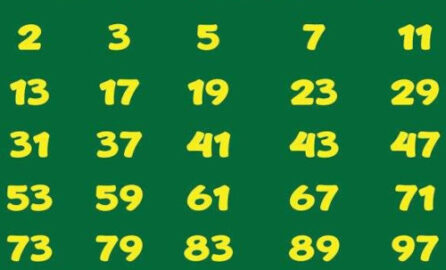Prime number – Definition, Examples and Explanation
A natural number that has exactly two divisors i.e. 1 and the number itself is called prime number.
Example (1):
2 has exactly two divisors i.e. 1 and 2. So, 2 is a prime number.
Example (2):
3 has exactly two divisors i.e. 1 and 3. So, 3 is a prime number.
Example (3):
4 has more than two divisors i.e. 1, 2 and 4. So, 4 is not a prime number.
Example (4):
1 has less than two divisors i.e. only 1. So, 1 is not a prime number.
History of prime numbers:
The ancient Greeks studied prime numbers in 1550 B.C. Euclid was the first mathematician who studied prime numbers. He is known as father of geometry. Most of the basic knowledge of prime numbers was theorized by Euclid.
Importance of prime numbers:
- The importance of prime numbers can be understood by a number theory theorem that every natural number greater than 1 can be written as a product of one or more prime numbers.
- Prime numbers are building blocks of whole numbers.
- Prime numbers are used as secret codes because it is very difficult to find out their prime factors.
Applications of prime numbers:
- Prime numbers are used for cyber-age security.
- Prime numbers are used in creating error-correcting codes. These codes are used in telecommunication sector.
- Prime numbers work as building blocks in creating public key cryptography algorithm.
Primality:
The property of being prime is called primality.
Prime numbers – When to Teach?:
Students of grade 4 are recommended to start learning prime and composite numbers. However, you may tell your child about prime numbers before this age group if the child is showing interest in the topic.
Word Problems on Prime Numbers:
Question (1):
Ahmad wrote the following numbers on his notebook. Which of them is a prime number?
35, 39, 37 and 33
Answer:
37
Question (2):
Ali wants to write two prime numbers whose sum is 36. Tell all possible pairs.
Answer:
- 5 and 31
- 7 and 29
- 13 and 23
- 17 and 19
Question (3):
A number was printed on the shirt of Mr. Abbas. This number was not a prime number. Which of the following numbers was printed on his shirt?
51, 47, 29, 23
Answer:
51
Question (4):
What is the sum of first two prime numbers?
Answer:
First two prime numbers are 2 and 3.
2 + 3 = 5
So, the sum of first two prime numbers is 5.
Question (5):
What is the sum of first three prime numbers?
Answer:
First three prime numbers are 2, 3 and 5.
2 + 3 + 5 = 10
So, the sum of first three prime numbers is 10.
Question (6):
What is the sum of first four prime numbers?
Answer:
First four prime numbers are 2, 3, 5 and 7.
2 + 3 + 5 + 7 = 17
So, the sum of first four prime numbers is 17.
Some Facts about Prime Numbers:
- 1 and 0 are not prime numbers because:
- 1 has only one divisor i.e. 1 itself but a prime number must have exactly two divisors i.e. 1 and the number itself. So 1 is not a prime number.
- Similarly, 0 does not have exactly two divisors. So 0 is not a prime number.
- 2 is the only prime number which is also an even number.
- Prime numbers cannot be counted i.e. they are infinite.
- No any prime number other than 5 ends in a 5.
- Every even number greater than 2 can be written as sum of two prime numbers.
Note:
Trial division is used to check primality of a given number.


Leave a Reply